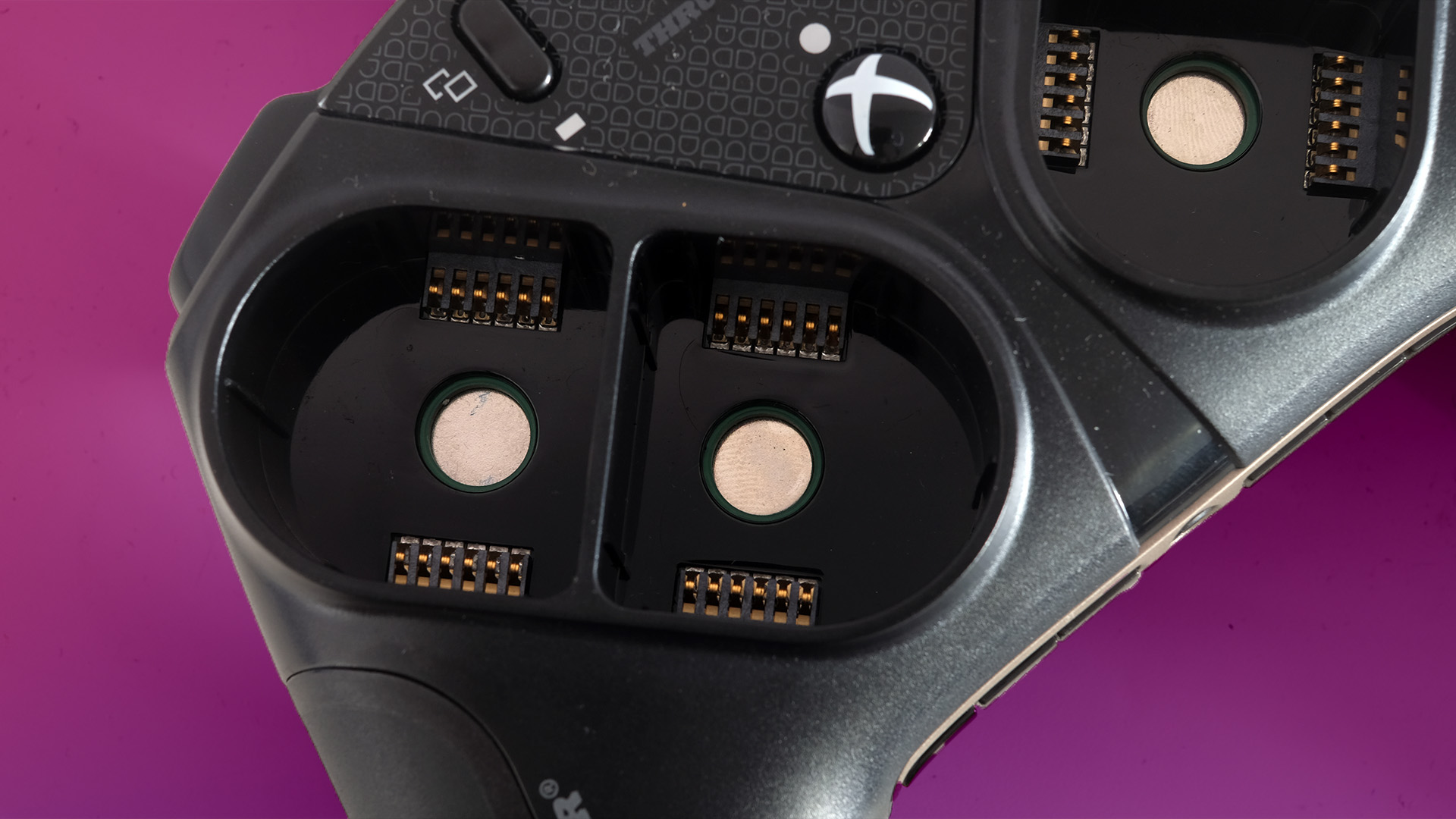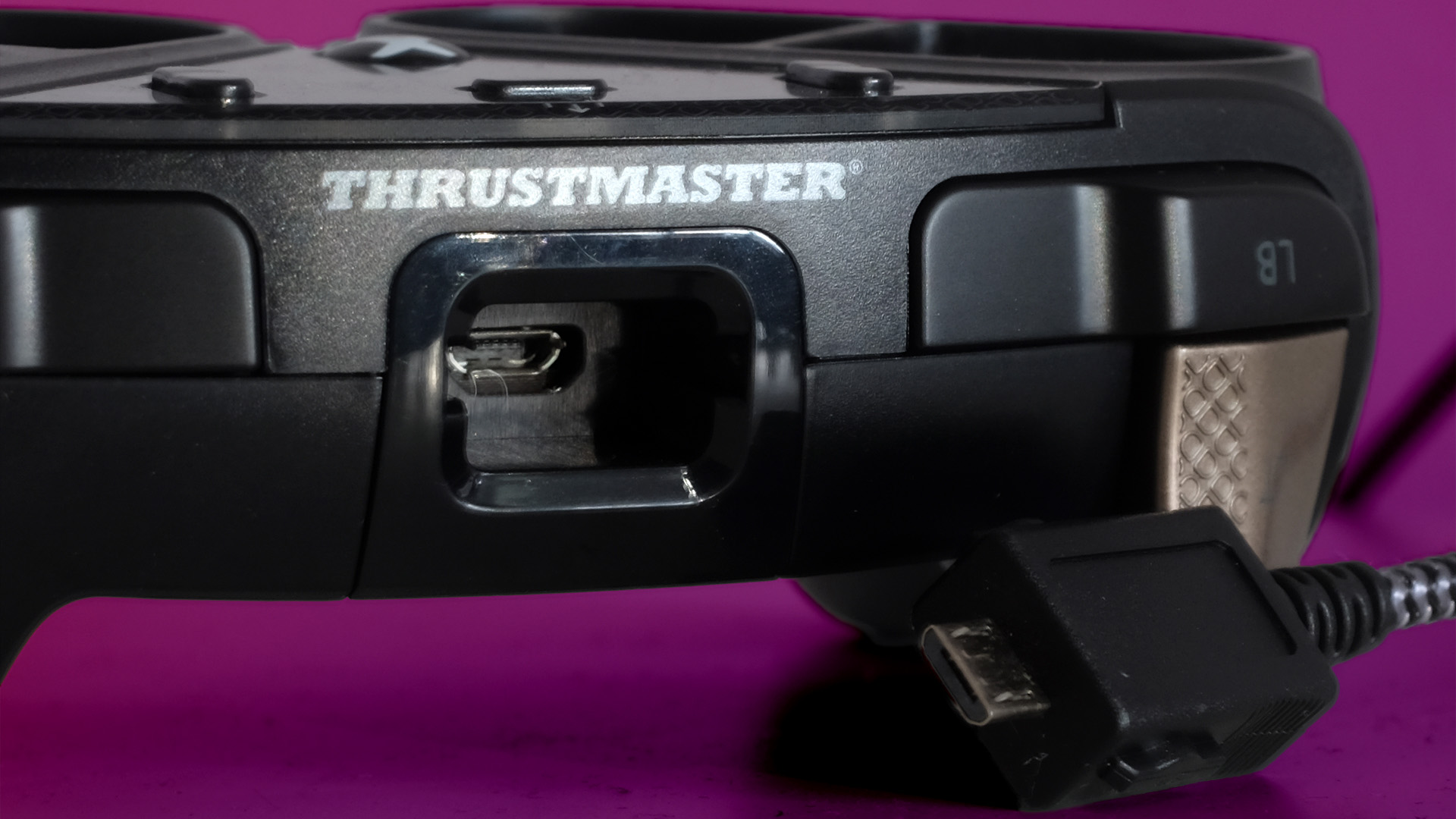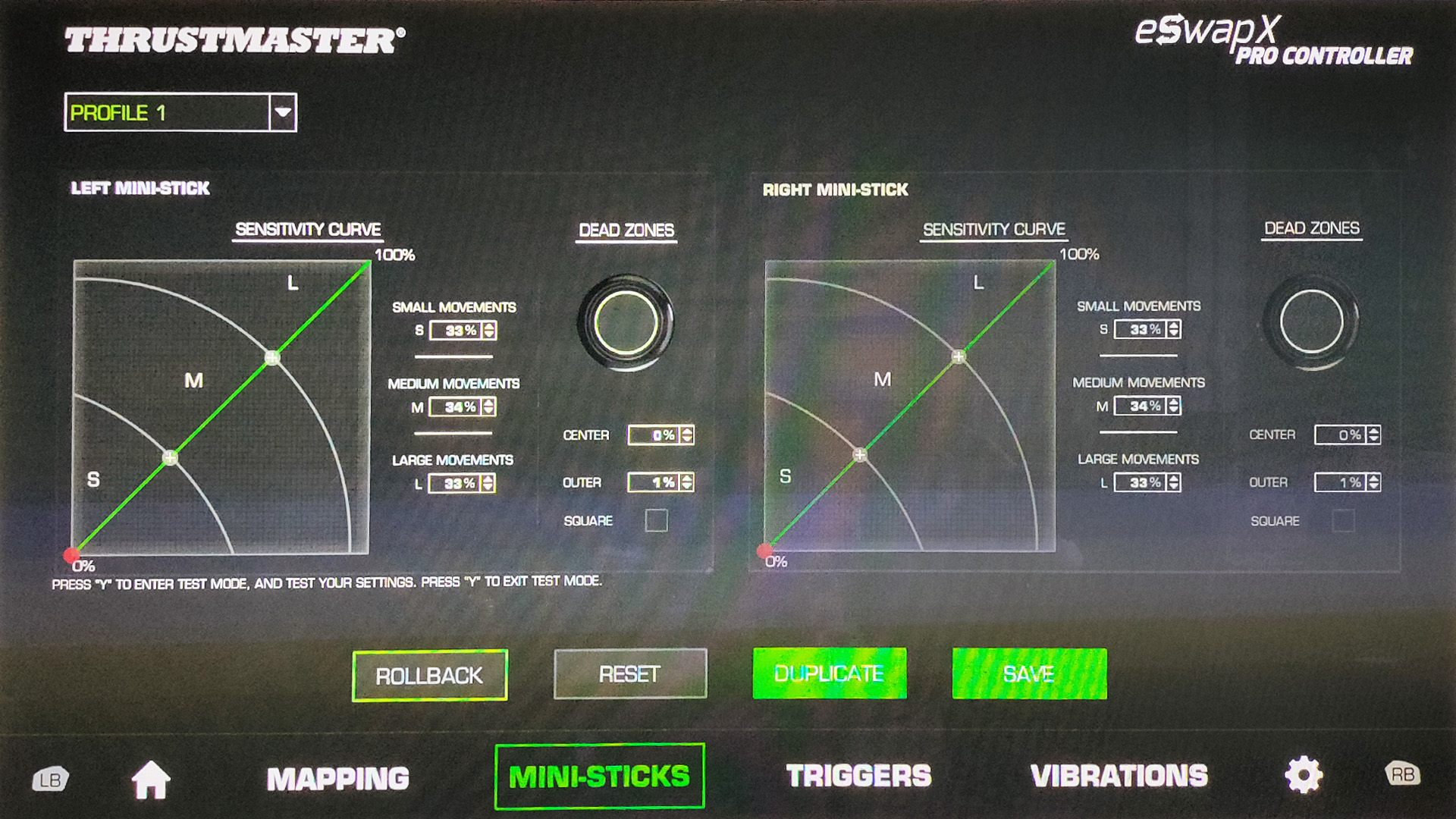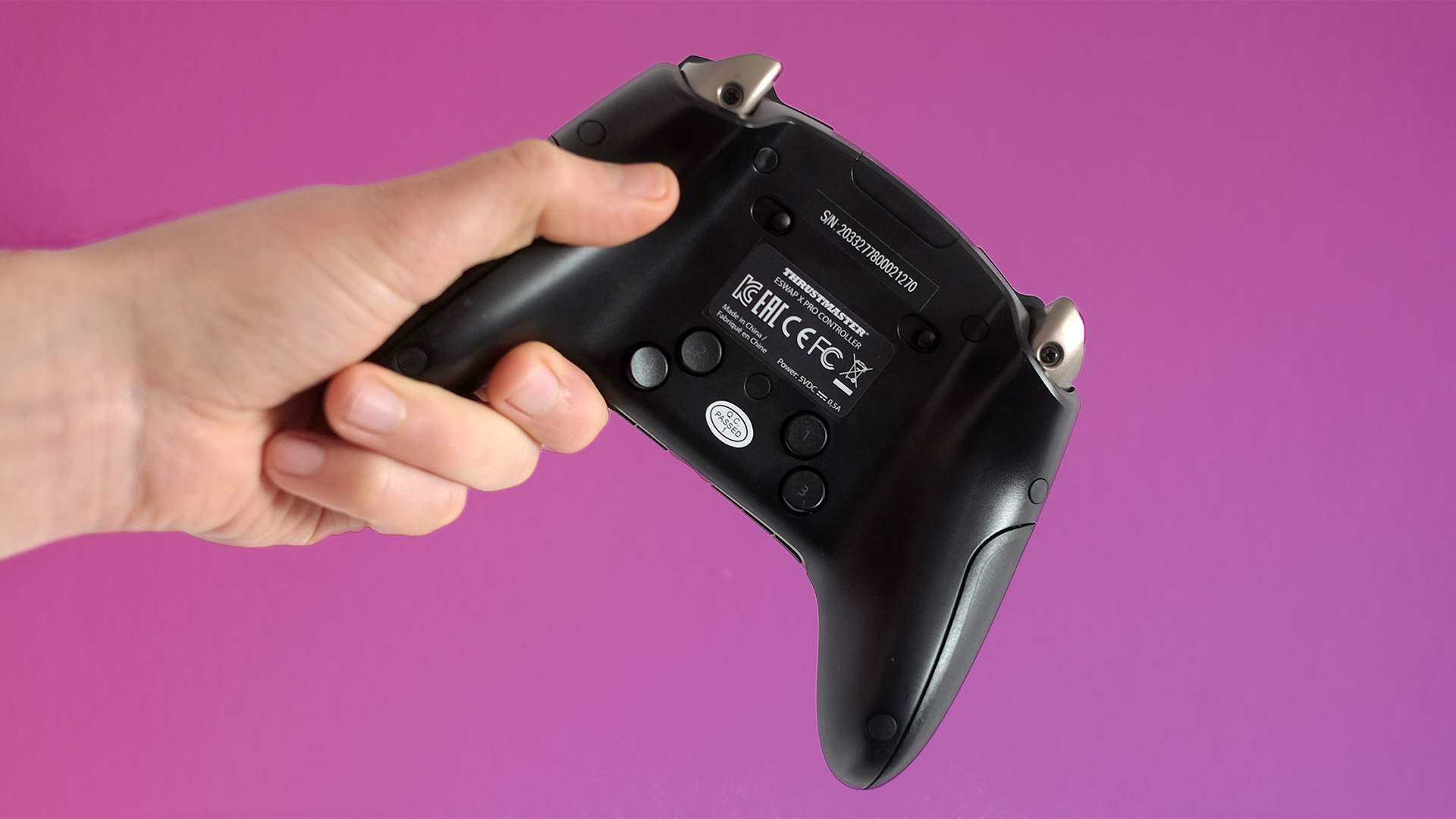TechRadar Verdict
A quality Xbox and PC pad with the most accessible component-switching system around. But the lack of wireless, rear button design and its less-than-pretty face may put some of you off given its high cost.
Pros
- +
Well-defined button feedback
- +
Good build quality, has some heft
- +
Modular system has great potential
Cons
- -
Rear buttons aren't the best
- -
No wireless
- -
Not particularly attractive
- -
Expensive
Why you can trust TechRadar
Two-minute review
The Thrustmaster eSwap X Pro is a high-end gamepad for Xbox Series X, Xbox Series S, Xbox One and PC. It costs a packet but has many features not found in your basic Xbox controller.
These include an awesome level of customization whether you play on PC or console, additional rear buttons and adjustable triggers.
The “eSwap” part is the Thrustmaster eSwap X Pro unique selling point, though. Its two analog sticks and D-pad can be removed and switched for other ones. You can swap the left stick and pad around, or get a new set of a different color.
Side panels can be switched out too, and it all only takes a second as these modules and panels are held in place with magnets, not screws. Other expensive pads may let you change components, but it usually requires some DIY.
The Thrustmaster eSwap X Pro’s eSwap system does not yet exploit one of the most obvious routes: a D-pad made from the ground up for one-on-one fighting games.
Thrustmaster’s included one is decent, but we’re not convinced it’s better than (or even perhaps as good as) the Xbox One pad for those thumb-rolling Hadouken gestures. And Microsoft improved the Xbox Series pad in this regard for the Series X and Series S.
Some of you may also be surprised by the Thrustmaster eSwap X Pro’s lack of wireless, given its cost. There are solid reasons for this decision but it’s not good news if you have a living/gaming room of a decent size and want to use the eSwap X Pro as your main pad. At $160 / £180, you’d want to, right?
Sign up for breaking news, reviews, opinion, top tech deals, and more.
There’s no doubt the Thrustmaster eSwap X Pro is a top-quality gamepad. But it doesn’t quite match up to the Xbox Elite Wireless Controller Series 2 in some important respects.
Now let’s dig deeper into the details.
eSwap modular system

The Thrustmaster eSwap X Pro’s modular system is easily the most catchy part of this pad, and the obvious reason to buy instead of an Xbox Elite pad, Razer Wolverine or Scuf Prestige.
It’s a neat system. The D-Pad and analog sticks simply lift out, each connecting to twelve contacts on the pad’s mainboard. A magnet keeps them in place, and even the most violent mid-air swipe won't make them fall out. Yes, we tried. Repeatedly.
Slotted indents in the modules keep them in place. And while there’s a fraction of a millimetre of wobble if you go looking for it, by yanking these modules back and forth, it’s nothing you can actually notice in play. Much more force is required.
So, what’s the eSwap thing actually for?
While there is a concept render of more unusual modules, the new sets you can buy right now are all about colour. There’s a blue one and a green one. They cost $50/£45.
More specialized packs may be on the way, as Thrustmaster made a “Fighting” pack for the PS4 “non Pro” eSwap, which includes a D-pad made just for fighting games. This kinda thing single-handedly justifies the concept.

For now, the Thrustmaster eSwap X Pro lets you switch around the D-pad and analog sticks. And, of course, replace the modules should they wear or malfunction. Single pads and sticks are available, so you shouldn’t have to buy a whole set, which isn’t far off the cost of a standard Xbox pad.
One of the customizations you’ll want to try out first doesn’t need the eSwap system at all. The stick caps screw into the balls they sit on, and you get two sets in the box.
Thrustmaster’s default has the familiar concave top. There are also convex ones, with a rounded top like those of the PS3 pad. Each pair has a nice high-friction rubber surface. We find the best type to use depends on the style of game you play.
Build quality

While the Thrustmaster eSwap X Pro is a very well-made pad, it is almost entirely plastic. Applying a lot of torsion we could get one bit on the left side to "click" under pressure, but it groans less than a standard Xbox One pad. This suggests the plastic used are suitably thick and tough.
There are no rubberized or soft-touch parts to the grip, as seen in the Razer Wolverine and Xbox Elite Controller, which is a shame. However, ergonomic choices are solid.
The Thrustmaster eSwap X Pro is comfy to hold for hours-long gaming sessions. Thrustmaster has chosen to make the stems of the grip splay out a little less than some, which makes your palms sit a little closer together. But it hasn’t introduced any comfort issues, with our hands at any rate.
Strip off the magnets, the removable modules and other design cleverness, and you’re left with a fairly conventional plastic shell. It’s a reminder much of what makes a pad seem expensive is the weight. The Thrustmaster eSwap X Pro weighs 320g, according to Thrustmaster’s specs and our scales, which is 25g less than the Xbox Elite Controller Series 2: in the same ballpark.
After looking at the competition to see what else you might spend your $160 on, we can’t help but conclude the Thrustmaster eSwap X Pro is a little ugly. You can’t really make a hot-swap modular controller without it looking like a Frankenstein creation. And that just isn’t the case with the SCUF Prestige, Razer Wolverine or Xbox Elite Controller Series 2.
Wired vs Wireless

The Thrustmaster eSwap X Pro is purely a wired controller. Almost all third-party Xbox pads are wired because Microsoft uses a proprietary wireless system. Companies like Thrustmaster cannot simply bung a Bluetooth or Wi-Fi chip in their pads and have it work with Xbox consoles as well as the first-party ones.
Some companies get around this by using their own wireless dongles that plug into the console’s USB port. But with this method, you are unlikely to get the same low latency and strong signal as Microsoft’s system.
Why compete if you can’t win, and will look pretty bad for losing?
The Thrustmaster eSwap X Pro’s wired approach means there are no latency issues, and the USB cable has a reinforced and secured terminal to avoid cable-yanking incidents ending in a dodgy socket. You get a 3m cable in the box, which — for our setup — is not quite long enough to leave a comfortable amount of slack. Bummer.
Thrustmaster does not appear to sell a longer version. Just buy a USB extender cable if you need a greater length.
Still, issues like this are why we prefer wireless pads for most kinds of play, when the fractional latency of a great wireless system isn’t an issue.
Customization

Third-party pads like the Thrustmaster eSwap X Pro always make you assess your priorities. Customization outside of the modular system is another highlight here.
Thrustmaster lets you perform tweaks on Xbox at the level you might usually only see on PC. An app lets you alter the sensitivity of the triggers, the input curves of the sticks and map the rear buttons (and others). You can also change the power of the rumble motors.

There are four sets of these. The “big rumble” sits on the left side, used for explosions and whatnot. A less powerful motor to the right of the pad handles lower amplitude rumble, and there are smaller still rumble motors in each trigger. The full complement.
The app lets you create presets, to apply to different games.
You can also modify button presets on the pad itself, using the row of controls by the headphone jack on its bottom edge. But why do so if the app is much easier? That said, buttons alongside the “map” button also let you switch between two main profiles, which is great.
The Thrustmaster eSwap X Pro’s triggers can also be swapped out, but this requires the use of a small screwdriver. And they, you guessed it, can be customized on the pad itself too.
A pair of switches on the back alters the depth of the triggers' travel. Make it shorter and the distance to reach a full 100% press is cut down. However, this wasn’t the first thing we noticed about these switches. It also alters how the trigger depress feels. The full travel depth ends in a mellow clonk. Curtail it and you get a bright click instead.
You can't just change how the Thrustmaster eSwap X Pro's triggers behave, but how they feel too.
Buttons and their quality

The Thrustmaster eSwap X Pro demonstrates a lot of this use of "clickiness" to signal a button actuation. And it is more obvious in the A/B/X/Y buttons.
They have shallower travel than an Xbox pad, ending in a very distinct click. As such, they are quicker to press, without sacrificing feedback whatsoever. Our first thought: “ooh, these are kinda nice”.
It’s undoubtedly a different feel to the current first-party pads, but one that seems a good fit for the kind of serious gamer who might buy a Thrustmaster eSwap X Pro.
The analog sticks are also exceptionally smooth. There’s zero of the mild granularity that’s common when you push a stick around its motion radius with some force. They are taller than average, presumably to offer finer-grain control, and you can buy replacement Mini-Stick modules for £17.99. We assume the US price will be around $20.
There’s more of this use of tactile clickery in the D-pad too. As you hit each of the 8 directional triggers underneath you will feel and hear a bright hit of feedback.
However, as noted earlier it’s not necessarily the very best design for fighters like Street Fighter 30th Anniversary Collection or Mortal Kombat 11. Rolling your thumb across the heavily contoured surface just isn’t that comfortable.
We are also not huge fans of the rear controls, one of the mainstays of ultra-expensive pads like the Thrustmaster eSwap X Pro. The Xbox Elite Controller uses removable paddles, which put these controls right where you want them to be.
These are fairly small buttons, and we just haven’t managed to get into their groove. You’re meant to tap them with your middle fingers, letting you keep your thumbs on both sticks.

We don’t love these, and have found it quite easy to accidentally press them when casually playing a game that doesn't need this kind of control, Slay the Spire in our case. Razer’s Wolverine offers a sort-of half-way solution, with much larger centrally positioned rear buttons.
Anything else to consider? As you’d probably guess the Thrustmaster eSwap X Pro has a 3.5mm socket for headsets.
Verdict
The Thrustmaster eSwap X Pro is a high-quality pad with a modular stick and pad system that lets you switch its components in a matter of seconds without any tools.
We love the idea, but let's hope Thrustmaster does a little more with it as we care more about how a D-pad feels than if it is black or green. The eSwap system aside, you might want to consider a Thrustmaster eSwap X Pro over a regular Xbox controller for its highly tactile buttons. Face buttons and the D-pad use positive clicks to accompany actuations, providing a degree of confidence with each and every press.
However, at roughly the same price as the Xbox Elite Controller Series 2, the Thrustmaster eSwap X Pro's lack of wireless support and the so-so rear buttons make this a qualified recommendation at most.
- Best PC controllers 2021: the best game controllers for PC gaming

Andrew is a freelance journalist and has been writing and editing for some of the UK's top tech and lifestyle publications including TrustedReviews, Stuff, T3, TechRadar, Lifehacker and others.
